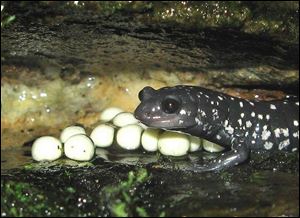
Slimy salamander spawns: Rare breeding is good news at Toledo Zoo
10/22/2007
A female slimy salamander protects her eggs in an exhibit at the Toledo Zoo. She protects her eggs with a coating of slime.
Mama salamander is ready for a fight.
If any of the other 20 or so salamanders housed with her even dares to sidle over to peek at her 18 eggs, she charges and bites.
And, yes, the six-inch amphibian has the teeth to make her threats a little more pointed.
The egg clutch she protects marks the Toledo Zoo's first instance of slimy salamander reproduction.
"It may be the first captive breeding ever," says Tim Herman, the herpetology keeper who watches over the salamanders. But that's not anything he can say for certain.
"They're very difficult to breed," said R. Andrew Odum, the zoo's herpetology curator. "And there are very few people really taking on the challenge."
The black salamander with stylish white polka dots is a good mom for an amphibian. Her protective behavior is an indication that the eggs are fertile. Unfertilized eggs are typically abandoned.
Not only does mom keep curious cage-mates at bay, her slimy skin is also protective, Mr. Herman said. The slime carries a bacteria that seems to protect eggs from fungi. The slime is also a defensive measure. If you pick up one of these salamanders, your fingers will stick together. Or, if you're a snake, your mouth may stick closed.
Once the youngsters hatch, probably in early December, they'll spend some time with their mother before dispersing, Mr. Herman said. Unlike many amphibian young, slimy salamanders do not have an aquatic stage, completing development within the egg.
Slimy salamanders, Plethodon glutinosus, are lungless. These terrestrial animals breathe through their skin. In some forests, plethodons are so abundant, they together outweigh every other animal population in the area.
Slimy salamanders are native to Ohio, but probably get no closer to Toledo than Erie County. They are more plentiful in the southern part of the state, where they live under rocks and logs in the warmer months. They're believed to move underground in cold weather, Mr. Herman said.
Because zookeepers rarely identify individual amphibians, it's not possible to tell if mom salamander arrived here with a group collected in 1999, or another group collected in 2004. In any event, the animals can live for more than 20 years, and do not reach sexual maturity until age 4.
Not only is this slimy mother thoughtful to her young, she's thoughtful to zoo visitors. She laid her eggs front and center in the exhibit, which is in the Diversity of Life building.
The Toledo Zoo hopes to work in cooperation with Central American countries to save salamander species endangered by a worldwide outbreak of chytrid fungus.
That makes this accidental exercise in captive breeding "good practice for us," Mr. Herman said, since little is known about salamander breeding in general.
"We're beginning to break the nut, learning how to do this and deal with salamanders," Mr. Odum said.
The zoo also recently played midwife to its first golden frog birth. The frog, Atelopus zeteki, is the national symbol of Panama and is severely endangered from the chytrid fungus outbreak.
One of the zoo's yellow frogs with black splashes laid a clutch of eggs, which can now be seen - but only by people with very good eyesight - as punctuation-size tadpoles.